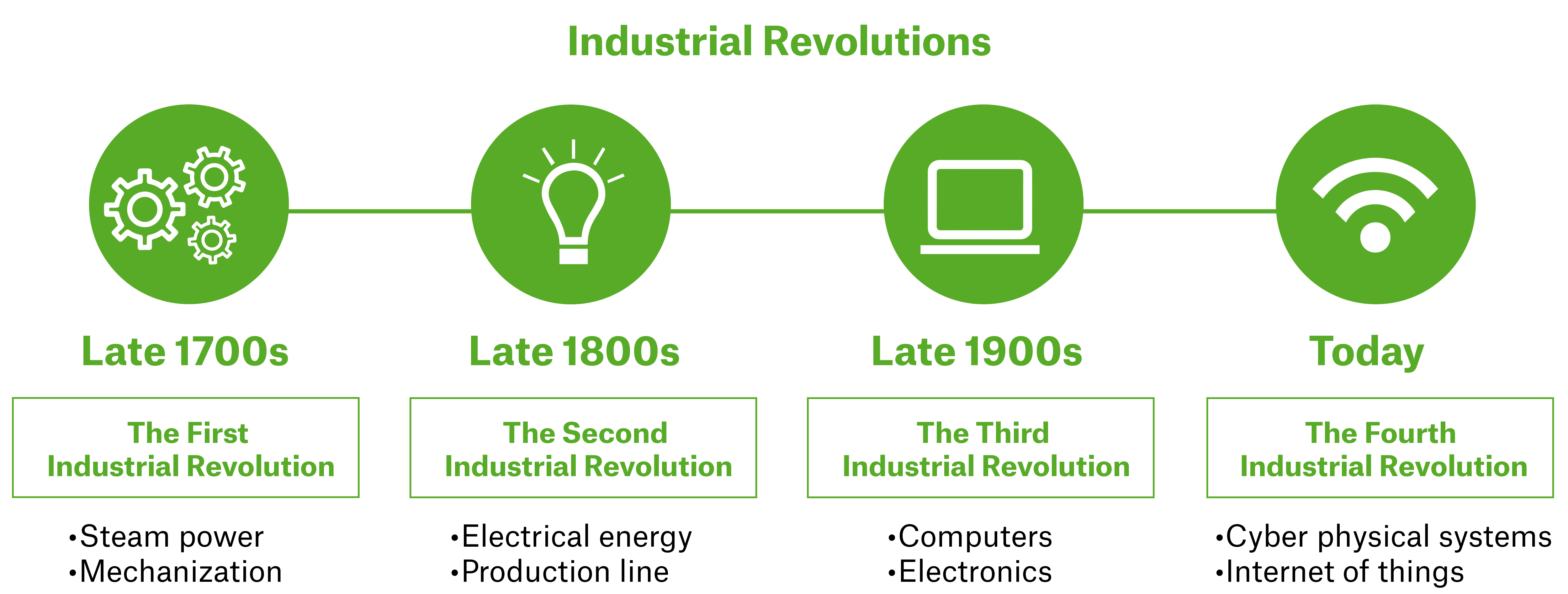
Discover the trend, meet the trendspotter.
The fourth industrial revolution
properties.trackTitle
properties.trackSubtitle
The trendspotter
“I think the fourth industrial revolution has the potential to change the way we live, the way we operate, the way we work, and the way we do business.”
HSB Vice President, Engineering (Equipment Technology Lab)
You probably don’t think about trends that affect businesses and the equipment they rely on. But we do.
The trend
Did you know we’re living in an industrial revolution?
An industrial revolution is a fundamental transformation in the manner in which we live and work. You’re probably familiar with the original industrial revolution. It occurred in the early 1800s, and was propelled by steam power.
But there were two other industrial revolutions just as significant as the first. The second was generated by electricity, and the third by automation and computers. We’re now in the fourth revolution with technology - including electronics, the Internet of Things (IoT), artificial intelligence (AI), and other forms of connectivity - pulling us forward.

Sensors: The new eyes and ears of an operation
HSB’s equipment technology lab has been closely studying how sensors can be used to electronically monitor the health of equipment. This is being driven by a combination of factors. But it starts with the sensors. Over the years, they’ve become smaller and cheaper to produce - which means it’s more feasible to place them in or on almost any type of equipment.
Sensors gather information about equipment while it’s operating, and then transmit the data in real time to the cloud where it can be instantly analyzed. This provides an instantaneous view of the current health of the equipment.
In some ways, sensors are similar to having a maintenance person walk past the equipment and hearing a strange sound or detecting a vibration. But sensors are highly sensitive, and can pick up on more subtle clues that something is amiss at any moment. By doing so, repairs can be initiated before a breakdown occurs which could save businesses from the expense and inconvenience of a breakdown.
Who can benefit from sensor monitoring?
Any business that relies on electricity and virtually any type of equipment could benefit from using sensors. This includes large industries - such as semi-conductor and automobile manufacturers that monitor production lines to proactively identify faults before they become a bigger problem.
But it also includes smaller commercial entities. Think of hospitals that rely on critical equipment to protect the well-being of patients, or hospitality centers that trust HVAC systems to keep guests comfortable during conventions or wedding receptions. Equipment failures aren’t an option for these businesses.
Even consumers are taking advantage of sensor technology with smart products in their homes that alert them when a product isn’t operating efficiently or needs attention.
While manufacturers now frequently install sensors on their equipment at the factory level, businesses don't need to wait for capital improvements to purchase new equipment with this built-in technology. Opportunities exist to easily incorporate sensor technology within existing equipment.
How HSB is taking on the trend
HSB is ready for the fourth industrial revolution. In fact, we’ve been preparing for it (and future advancements) for years. From an engineering standpoint, we’ve learned from what other industries are doing, and applied that knowledge to key risk management issues.
Sensor Solutions by HSB™ offers a suite of sensors that detect water leaks and changes in temperature and humidity. Once an inconsistency is detected, the sensors send an alert so the issue can be addressed, if necessary, before damage occurs.
We’ve also helped facilitate the adoption of sensor technology by investing in partnerships with other organizations:
- Augury retrofits rotating machinery equipment - such as pumps, motors, fans, and blowers - with sensors when this technology wasn’t included by the manufacturer, and then continuously monitors vibration levels to determine the health of the equipment.
- Schneider Electric applies retrofitted sensors to electrical equipment, and monitors power voltage levels and other critical indicators to help prevent or limit dangerous electrical arc flashes. By doing so, Schneider improves loss prevention for businesses, and helps promote a maximum lifecycle for their equipment.
Those are just two examples of how we’re leveraging technology to better predict problems and prevent loss. At HSB, we’re constantly watching for trends, studying them, and identifying solutions.





